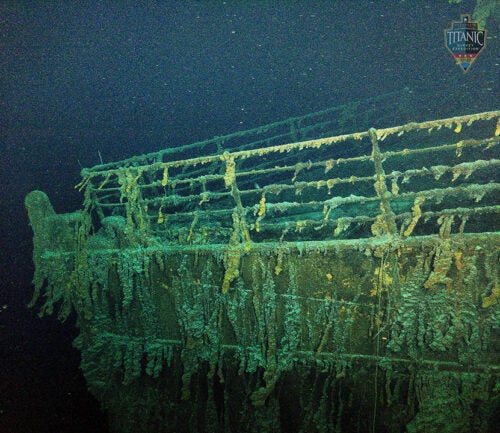URI to host educational open house for cutting-edge submersible that surveyed the Titanic
By Hugh Markey

OceanGate’s Titan, a five-person submersible that can dive to
depths of 4,000 meters, is towed behind a research ship.
(Photo courtesy of David Concannon)
This week, the University of Rhode Island hosts an open house for Titan, the five-crewmember submersible that recently completed a six-week expedition to document the Titanic maritime heritage site.
Titan is a unique carbon fiber and
titanium crewed submersible designed to take five people to depths of 4,000
meters (13,123 feet).
The submersible will be on the Kingston Campus Quadrangle from Thursday through Saturday, Oct. 14-16, from 10 a.m. to 2 p.m.
The open house is free and open to the public. Visitors will be required to wear masks and sign in to tour the submersible.
Professor
Bridget Buxton arranged the viewing of the submersible in cooperation with the
URI Research Foundation (URIRF) and OceanGate Inc., a company dedicated to
providing state of the art submersibles that make deep ocean exploration
possible for a wide variety of researchers and explorers. Buxton, chief
archaeologist of the Titanic Survey Expedition, and her team supported
OceanGate Expeditions during a series of 12,800-foot-deep dives to survey the
wreck of the Titanic.
 |
| An image of the Titanic wreck taken by the submersible Titan. (Photo courtesy of OceanGate Inc.) |
“We
are proud to be working with Professor Buxton and the University of Rhode
Island to share the importance of our innovative technology in supporting
crucial deep sea archaeological research. The OceanGate Inc. submersible,
Titan, is the first and only five-crewmember submersible to reach the Titanic,”
said Stockton Rush, president, OceanGate Expeditions. “This summer marked the
inaugural year for the Titanic Survey Expedition. The ongoing participation of
experts like Professor Buxton is an integral part of this longitudinal study to
document the wreck of the Titanic and its rate of decay.”
“OceanGate
decided to take Titan on a tour to introduce people to the submersible,” said
Buxton, an associate professor of Ancient History and Mediterranean
archaeology. “It’s exciting to share our dive experiences and to show some of
the footage and images we gathered during the expedition.”
The
URIRF is supplying the funds and organizing logistics for bringing the vessel
to the Quad. Michael Katz, executive director of URIRF, works on collaborations
between industry and URI faculty.
“When
I heard about this opportunity, I thought this would be great for our students,
faculty, and the general public to look at a state of the art, advanced
materials submersible,” said Katz. “It would be a chance to fire up some of our
students to get involved in cutting edge innovative ocean technology research.”
Katz
said part of the URIRF mission is to encourage a culture of entrepreneurship on
campus. Hosting Titanin Kingston is a good example of the partnership between
research and industry.
Buxton
said that work carried out using this submersible as a research platform was
part of a pioneering set of dives. “This is a revolutionary construction of
carbon fiber and titanium. I’m an underwater archaeologist, and one of the things
I’ve been very involved in the last 10 years is developing new technology to
make underwater research, and in particular archaeology, more accessible and
affordable to scientists and people in developing countries.”
Buxton
received a grant from the URI Council for Research to help develop an
affordable scanning sonar for oceanographic technology purposes. Her
involvement with the OceanGate, Inc. Titan submersible is part of this
research.
“The
submersible can be operated behind any ship,” said Buxton. “In addition to deep
ocean exploration, it can also be used in shallow and coastal areas. This
technology makes it much more affordable to do oceanographic research.”
Hugh
Markey, a freelance writer, wrote this press release.